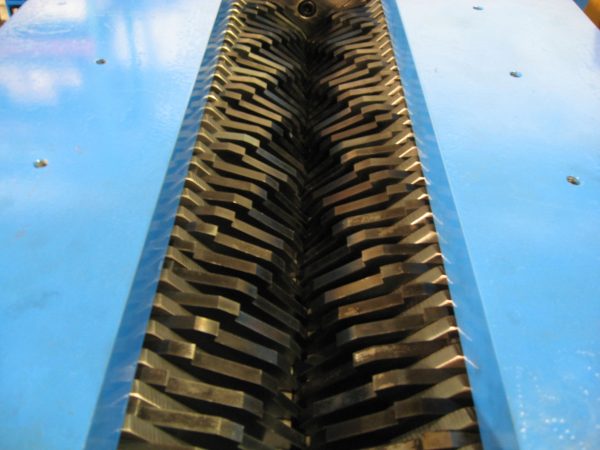
Canadian manufacturers stand to benefit from in-house plastic shredders
by Del Williams
Triplus knife system is capable of shredding, chipping and sizing plastics in a single pass without utilizing a screen.

BCA Triplus Shredder
Traditionally, Canadian plastic product OEMs have shipped scrap and defective product to China or regional recyclers after shredding to reduce size for more manageable transport. Further grinding or granulating the plastic to a size suitable to mix with virgin plastic pellets has also enabled reuse in the manufacturing process to reduce input cost.
However, the cumbersome process of shredding, screening, and grinding the plastic to size with different equipment in separate processes has not only been inefficient but also a bottleneck to production.
Now, for the OEMs of a wide range of plastic products such as car bumpers, barrels, bottles, garbage cans, gas cans, paint cans, as well as film and wrap, industry innovation has developed a much more efficient alternative: shredder knife technology that can cut, screen, and size in a single pass with one machine on-site.
Because the sizing of reduced plastic scrap can be specified, uniform, and even tailored to the manufacturing process, more material can be successfully reused with less labor and processing, boosting profits. Shipping costs are also reduced for scrap transported off-site to be recycled since any voids (i.e.- empty spaces) within the container are minimized.
Conventional Equipment Limitations
For decades, the reduction of large plastic scrap or unusable product has usually involved shearing equipment such as dual or quad shaft shredders. To further decrease size, this is typically followed by the use of grinding machinery such as granulators, stone mills, tub grinders, or chippers.
Screeners are often used at various points, which decreases processing speed. As an example, “A standard dual shaft shredder typically turns shredder material into strips and requires the use of a re-screening device to reduce plastic material to a specific size,” says Doug Bartelt, President of Milwaukee, WI-based BCA Industries, a developer and manufacturer of industrial shredding and recycling equipment.
“Both the shredder and granulator create various sized material. Usually, this is determined by a random event in how the material is fed into the system in terms of speed, timing, etc., which results in about 40 to 50 percent incorrectly sized material. So, efficiency on either of these systems only approaches around 50%,” explains Bartelt.
Efficiently Reducing Scrap to Size
Seeking a better way to size scrap material like plastic, Bartelt and his brother discovered a more efficient way to size without a screen. The insight was developed into BCA’s patented Triplus knife system technology, which changes a standard shredder to a hybrid between a dual shaft rotary shear shredder and a single shaft granulator.
Unlike traditional equipment, the knife system is capable of shredding, chipping, and sizing any kind or size of plastics in a single pass without utilizing a screen. A shredder utilizing this design can produce over 85% correctly sized material in one pass with less than 10% oversized material, according to Bartelt.
Such regularly sized plastic material facilitates Canadian OEMs redirecting scrap back into their own onsite manufacturing process. This move towards more of a closed loop sourcing approach can not only dramatically reduce input costs, but also eliminate most, if not all, of the expense of shipping plastic materials to be recycled offsite.
By eliminating separate equipment and steps to shred, screen, and grind scrap to size – and combining this into a single function – the manufacturing process is expedited.
In addition to plastics, the knife system design effectively shreds and sizes a wide variety of materials including rubber, paper, cardboard, wood, fabric, copper wire, aluminum, fiberglass, and even garbage, and batteries.
Canadian OEMs needing to re-use or recycle plastic scrap or defective product have long resorted to overly complex in-house shredding, screening, and grinding processes as well as costly shipping to offsite recycling centers.
With industry innovation, however, OEMs now have the ability to quickly and efficiently cut plastic scrap and sub-par product to size onsite. This has the potential to both simplify production and reduce shipping costs to boost the bottom line.